Illuminated Ancient Manuscripts Reflect 1,000 Years Of Human History
A. Sutherland - AncientPages.com - Before the introduction of printing to Western Europe during the mid-15th century, all ancient books or manuscripts were written by hand.
Preparing a manuscript was not only a slow and expensive process but also demanding and hard work of a scribe.
 This ancient, beautifully illuminated manuscript is a codex of the four gospels (Tetraevangelion), made in Constantinople in the 12th century and was first listed by Spyridon Lambrou in his opus “Catalogue of the Greek Manuscripts on Mount Athos.”
This ancient, beautifully illuminated manuscript is a codex of the four gospels (Tetraevangelion), made in Constantinople in the 12th century and was first listed by Spyridon Lambrou in his opus “Catalogue of the Greek Manuscripts on Mount Athos.”
Some of the ancient, most luxurious manuscripts were illuminated by their masters, with sophisticated adornments like for example, pictures in brightly-colored pigments and burnished gold leaf and colorful graphic designs using silver and gold.
Illuminated manuscripts contain most of the finest surviving examples of medieval painting and the art of illumination flourished in the early centuries of Christianity when the manuscript codex, or book, gradually replaced the papyrus roll.
 Ethiopic illuminated Garima Gospels manuscript - Two pages with illuminated Eusebian Canons from Garima 1, likely the later of the two Garima Gospels - http://www.ethiopianheritagefund.org - Public Domain
Ethiopic illuminated Garima Gospels manuscript - Two pages with illuminated Eusebian Canons from Garima 1, likely the later of the two Garima Gospels - http://www.ethiopianheritagefund.org - Public Domain
By the end of the medieval era, as Europe became wealthier and more worldly, a great variety of texts, both religious and secular, came to be illuminated a variety of illuminated works are among the most astounding and intriguing objects ever created.
These great historical masterpieces reflect almost 1,000 years of human history, from around 600 to 1600. The origins of Western European illumination was the Christian British Isles, and the British Library's collection is one of the finest in the world.
Insular Manuscripts - (7th to 9th century)
'Book of Mulling' Irish pocket Gospel Book - source
These manuscripts were produced under Irish influence and Celtic culture, and developed the late antique practice of enlarging the first letter or initial at the beginning of a text into an entire page —known as a carpet page— which was covered with abstract designs.
Examples of insular manuscripts are Gospel Books and Psalters - the most significant biblical texts for Christian thought and prayer and at the same time, one of the most popular types of illuminated manuscripts in the Middle Ages.
Of all illuminated Insular manuscripts decorated by highly skilled artists, many biblical manuscripts survived and the tradition of using elaborately and beautifully decorated text pages in books of Gospels and other liturgical manuscripts flourished into the Ottonian and Romanesque periods.
Byzantine manuscripts - (6th to 15th century)
 A 12th-century Byzantine illuminated New Testament to the Holy Monastery of Dionysiou on Mount Athos in Greece.
A 12th-century Byzantine illuminated New Testament to the Holy Monastery of Dionysiou on Mount Athos in Greece.
In the Byzantine Empire, another tradition of manuscript illumination emerged from the 6th to 15th century. The illuminated manuscript played an important role in the development and spread of Byzantine art.
The most influential and significant characteristics of Byzantine manuscript painting were the abundant use of precious metals, especially gold; the choice of bright colors; the use of empty space, often filled with gold leaf background and a number of different styles to depict the human figure in Byzantine art over the centuries.
Byzantine illumination was frequently devoted to narrating biblical stories.
Carolingian Manuscripts - (8th to 9th century)
Charlemagne (or Charles the Great) King of the Franks and later Holy Roman Emperor, who reigned 800 - 814 encouraged artists, Carolingian illuminators to emulate the naturalism of the ancient Greeks and Romans.
Carolingian art survives in manuscripts, sculpture, architecture and other religious artifacts produced during the period 780-900. These artists worked exclusively for the emperor, members of his court, and the bishops and abbots associated with the court. Geographically, the revival extended through present-day France, Switzerland, Germany and Austria.
 The Ebbo Gospels (c. 816-35). The author portrait of St. Mark is characteristic of Carolingian art and the Carolingian Renaissance. The artist used distinctive frenzied lines to create the illusion of the evangelist's body shape and position. The footstool sits at an awkward unrealistic angle, but the body seems to depicted as a three-dimensional object in space. The right leg is tucked under the chair and the artist tries to show his viewer, through the use of curved lines and shading, that the leg has form. There is shading and consistency of perspective. The evangelist sitting on the chair strikes a believable pose.
The Ebbo Gospels (c. 816-35). The author portrait of St. Mark is characteristic of Carolingian art and the Carolingian Renaissance. The artist used distinctive frenzied lines to create the illusion of the evangelist's body shape and position. The footstool sits at an awkward unrealistic angle, but the body seems to depicted as a three-dimensional object in space. The right leg is tucked under the chair and the artist tries to show his viewer, through the use of curved lines and shading, that the leg has form. There is shading and consistency of perspective. The evangelist sitting on the chair strikes a believable pose.
Carolingian manuscripts are presumed to have been produced largely or entirely by clerics in a few workshops around the Carolingian Empire during the reign of Charlemagne covered most of Western Europe, as the Roman Empire once had.
Each of these workshops practiced its own style and even Charlemagne had his own center or scriptorium for copying and illuminating manuscripts, at Aachen, Germany. Under the direction of Alcuin of York, this scriptorium produced a new script known as Carolingian miniscule (writing) that spread from Aachen and was universally adopted, allowing for clearer written communication within Charlemagne's empire.
Carolingian miniscule was the most widely used script in Europe for about 400 years.
Ottonian Manuscripts - (10th to 11th century)
In the mid-10th century, a line of German kings including Otto I, Otto II, and Otto III began to commission manuscripts that, as in the Carolingian tradition, were to be a visual manifestation of imperial power.
The Ottonians were influenced by Byzantine art, using a narrative style that expresses the gravity and simplicity of Byzantine icons.
 Ottonian Manuscripts - (10th to 11th century)
Ottonian Manuscripts - (10th to 11th century)
The volumes of the figures and the spatial relationships are reduced to luminously colored patterns. The figures have large, expressive eyes and long, gesturing hands—motifs that are also derived from Byzantine art.
Ottonian art - particularly manuscript illumination, metalwork and ivory carving, and most surviving Ottonian illuminated manuscripts were created for a sacred purpose; manuscripts were most often produced of religious texts, and usually included a dedication portrait commemorating the book’s creation. The royal or religious donor is usually shown presenting the book to the saint of his or her choice.
The Ottonians held mathematical sciences in high regard and this is reflected in many of their artistic works. The intense intellectual, cultural and religious climate inspired artistic masterpieces produced by Ottonian “scriptoria” or monastery painting and writing schools.
Romanesque Manuscripts - (11th to 12th century)
Romanesque art was international in character, borrowing from both Insular and Byzantine art. It was created in Western Europe in approximately 1000 AD.
The Insular focus on initials became the central element in Romanesque illumination, and the historiated initial, which contains an illustrative scene, was derived from the Byzantine interest in narrative.
 Romanesque Manuscripts - (11th to 12th century)
Romanesque Manuscripts - (11th to 12th century)
The great examples of Romanesque manuscript illuminations with very popular decorations, striking colors and patterned backgrounds along with abstract drapery were used in the Bible or other religious texts.
Each book could be prefaced by a large historiated initial, also major initials were similarly illuminated as well. The Bibles often had a very large page size.
The Stavelot Bible, written over four years at Stavelot in what is now Belgium in the late eleventh century.
Several great examples of Romanesque manuscripts. One of them is for example, the outstanding early manuscript from its scriptorium, the Stavelot Bible, of about 1094 - 97, which is the work of many artists.
Gothic Manuscripts - (13th to 15th century)
By the end of the 12th century, Parisian artisans had developed a new style of illumination characterized by sinuous figures, vivid narratives, and the lavish use of gold leaf. During the 13th century the English and German schools developed Gothic styles as well.
 The ‘Douce Apocalypse’ (Bodelian Library)
The ‘Douce Apocalypse’ (Bodelian Library)
In England the art of illumination flourished widely in the second half of the 13th century. It was a time, in which the connections with the continent, particularly France, were strong.
Artists left the monastic scriptorium and moved into professional workshops in the city's centers. Many wonderful works - based on different styles and techniques of illumination - were created in this period of time.
Written by – A. Sutherland - AncientPages.com Senior Staff Writer
Copyright © AncientPages.com. All rights reserved. This material may not be published, broadcast, rewritten or redistributed in whole or part without the express written permission of AncientPages.com.
Expand for referencesMore From Ancient Pages
-
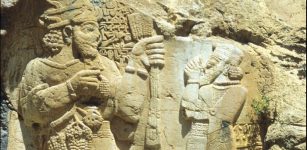 Ivriz Relief: 3,000-Year-Old Hittite Relief – Oldest Known Symbol Of Agricultural Fertility In History
Artifacts | Jun 13, 2019
Ivriz Relief: 3,000-Year-Old Hittite Relief – Oldest Known Symbol Of Agricultural Fertility In History
Artifacts | Jun 13, 2019 -
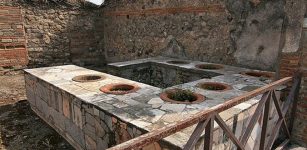 Thermopolium – Ancient Roman Restaurant Offered Fast Food But Was It A Good Idea To Eat There?
Ancient History Facts | Mar 16, 2018
Thermopolium – Ancient Roman Restaurant Offered Fast Food But Was It A Good Idea To Eat There?
Ancient History Facts | Mar 16, 2018 -
 Unique Belongings Of Bronze Age Warrior Offer Evidence Of Massive Violent Conflict In Europe
Archaeology | Oct 18, 2019
Unique Belongings Of Bronze Age Warrior Offer Evidence Of Massive Violent Conflict In Europe
Archaeology | Oct 18, 2019 -
 Latin America’s Oldest Beer Resurrected From 400-Year-Old Yeast
Archaeology | Aug 4, 2022
Latin America’s Oldest Beer Resurrected From 400-Year-Old Yeast
Archaeology | Aug 4, 2022 -
 Hundreds Of Fascinating 24,000-Year-Old Cave Paintings Discovered In Eastern Iberia
Archaeology | Sep 11, 2023
Hundreds Of Fascinating 24,000-Year-Old Cave Paintings Discovered In Eastern Iberia
Archaeology | Sep 11, 2023 -
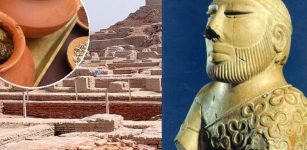 Cooking In Indus Valley – Leftovers In Prehistoric Kitchen’s Vessels Analyzed
Archaeology | Mar 24, 2022
Cooking In Indus Valley – Leftovers In Prehistoric Kitchen’s Vessels Analyzed
Archaeology | Mar 24, 2022 -
 Did Queen Nitocris Build A Secret Underground Chamber To Commit Murder?
Featured Stories | Nov 12, 2020
Did Queen Nitocris Build A Secret Underground Chamber To Commit Murder?
Featured Stories | Nov 12, 2020 -
 Did Two Daughters Of Akhenaten Rule Together Under One Name Before Tutankhamun?
Archaeology | May 1, 2019
Did Two Daughters Of Akhenaten Rule Together Under One Name Before Tutankhamun?
Archaeology | May 1, 2019 -
 Hundreds Of Ancient Sealed Wine Jars Found In Mysterious Tomb Of Meret-Neith In Abydos
Archaeology | Oct 2, 2023
Hundreds Of Ancient Sealed Wine Jars Found In Mysterious Tomb Of Meret-Neith In Abydos
Archaeology | Oct 2, 2023 -
 Unknown Saxon Village And Bronze Age Artifacts Found Near Ely, Cambridgeshire
Archaeology | Sep 18, 2023
Unknown Saxon Village And Bronze Age Artifacts Found Near Ely, Cambridgeshire
Archaeology | Sep 18, 2023 -
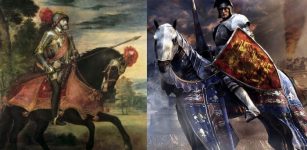 The Word Freelancer Originates From Medieval Mercenary Knights
Ancient History Facts | Feb 25, 2016
The Word Freelancer Originates From Medieval Mercenary Knights
Ancient History Facts | Feb 25, 2016 -
 Family Looking For Lost Gold Ring Finds Viking Age Artifacts In Their Garden On The Island Of Jomfruland
Archaeology | Sep 30, 2023
Family Looking For Lost Gold Ring Finds Viking Age Artifacts In Their Garden On The Island Of Jomfruland
Archaeology | Sep 30, 2023 -
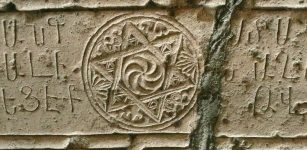 Ancient Iconic Armenian Wheel Of Eternity Depicted Inside A Six Pointed Star
Ancient Symbols | Feb 27, 2017
Ancient Iconic Armenian Wheel Of Eternity Depicted Inside A Six Pointed Star
Ancient Symbols | Feb 27, 2017 -
 Children Of Lir And Aoife’s Curse – Celtic Legend That Inspired The Swan Lake Ballet
Featured Stories | Feb 8, 2024
Children Of Lir And Aoife’s Curse – Celtic Legend That Inspired The Swan Lake Ballet
Featured Stories | Feb 8, 2024 -
 Ancient Native American Stories Of Great Floods In Tennessee Confirmed By Scientists – 1867 Flood Was Not The Worst One
News | Aug 26, 2020
Ancient Native American Stories Of Great Floods In Tennessee Confirmed By Scientists – 1867 Flood Was Not The Worst One
News | Aug 26, 2020 -
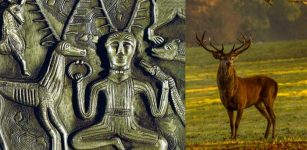 Cernunnos ‘Horned One’ – Powerful Continental God Preserved In Celtic Beliefs As Master Of Animals
Celtic Mythology | Dec 18, 2018
Cernunnos ‘Horned One’ – Powerful Continental God Preserved In Celtic Beliefs As Master Of Animals
Celtic Mythology | Dec 18, 2018 -
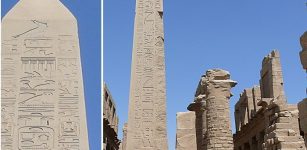 Unknown History Of Gigantic Obelisks Created With Ancient Lost Technology
Ancient Technology | Oct 8, 2017
Unknown History Of Gigantic Obelisks Created With Ancient Lost Technology
Ancient Technology | Oct 8, 2017 -
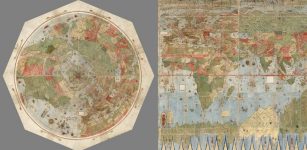 Unique Ancient Map Depicting The Earth As Seen From Space Restored Digitally
Archaeology | Dec 18, 2017
Unique Ancient Map Depicting The Earth As Seen From Space Restored Digitally
Archaeology | Dec 18, 2017 -
 How ‘Listening’ To Archaeological Sites Could Shed Light On The Past
Archaeology | Dec 8, 2023
How ‘Listening’ To Archaeological Sites Could Shed Light On The Past
Archaeology | Dec 8, 2023 -
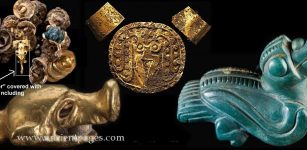 Mysterious Golden Lords Of Panama
Artifacts | Aug 23, 2018
Mysterious Golden Lords Of Panama
Artifacts | Aug 23, 2018


